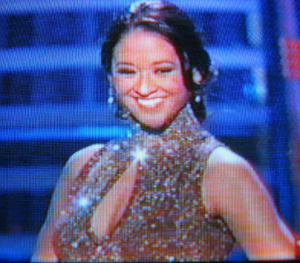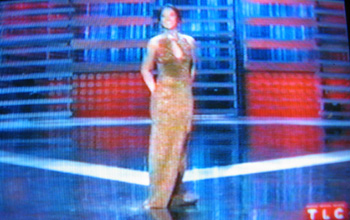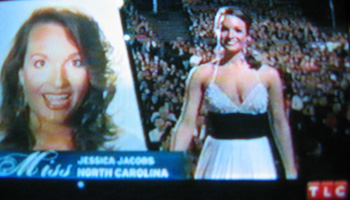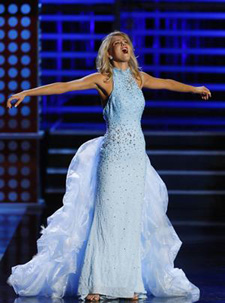Musings
an Online Journal of Sorts
By Alyce Wilson
January 30, 2008 - Still Sequined
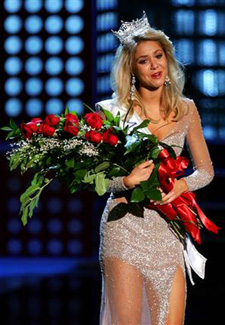
Ethan Miller/Getty
Images
Miss
America 2008,
Kirsten Haglund
Realizing that viewership was going the way of the Dodo, the organizers of the Miss America pageant this year made a bid for new viewers. The tactic: a reality show on TLC, dubbed Miss America: Reality Check, in which the contestants lived together in a house and faced weekly challenges designed to update the Miss America image.
The goal was to make Miss America the new "It Girl," someone who was style conscious, down-to-earth and a great role model. Experts worked with the contestants to tone down their makeup, update their hairdos, and teach them that it really was OK to just be themselves.
The series had a certain charm, as the personalities of the various contestants surfaced and they challenged themselves to change their own perceptions about beauty and about themselves. In particular, one of the most heartwarming stories was that of one contestant who had suffered a childhood burn accident and believed she had to cake on makeup to hide her scars. She learned, instead, that she was beautiful without all the help.
At the pageant, however, the contestants still seemed set in their ways, and for good reason. After all, the style-conscious judges they'd answered to for the reality show were nowhere to be seen, and instead, they were rated by the same mix of B-list celebrities and lightweights who always judge such pageants.
A few things did change. Clinton Kelly of TLC's What Not to Wear served as a secondary host, adding his own panache to the proceedings. His job was to hang out on stage with the contestants who were eliminated. They were all encouraged, as they joined him, to "eat some carbohydrates," as he offered them a tray full of pastries. As the show dipped to commercial breaks, a DJ spun tunes, and the pageant music was updated to a techno track suitable for a fashion show.
By the end of the evening, the contestants who sat relaxed and smiling with Clinton, who looked like everyday young women, as opposed to the finalists still competiting, who couldn't quite shake their plastic smiles.
After introducing all the contestants by having them reveal something funny about their state, the judges narrowed them down to the top 15. Of course, the top 10 had already been announced at the close of the reality series, so this was no big surprise. The top 15 did, however, include the contestant selected by audience vote to compete, namely Miss Utah, Jill Stevens, who was definitely one of the most down-to-earth contestants, a former combat medic and tomboy who confessed to knowing little about makeup and clothing.
If the organizers had truly wanted to change the pageant, though, the contest wouldn't have started with the swimsuits. Contestants were eliminated after each round, and unless the results were previously determined, this means several of them were cut merely on the basis of how they looked in a bathing suit. If the goal was truly to update Miss America, why not start with the question rounds, so the contestants could prove their ability to think on their feet? After all, in a practical sense, that is far more important to the duties of Miss America, who works as an advocate for her chosen cause, than whether she can strut in stilettos and a bikini.
The only contestant who took a real chance at being different in the swimsuit competition was Miss Utah, in a very flattering but more modest one-piece suit. Of course, she was eliminated right away, probably because she looked so uncomfortable walking the runway. That's too bad, because she'd shown herself, during the reality series, to have a sparkling, confident personality. She would have shone in the question rounds, for sure. Not one to whine about it, however, she good-naturedly did some pushups before taking her seat on the side of the stage.
Then came the evening gown competition, which truly showed how little had changed. While they'd received plenty of coaching about choosing a tasteful, fashion-forward gown, most went back to their old ways. Almost every single dress was a sequined atrocity, the sort of garment that Stacy and Clinton would mock on What Not to Wear.
Sadly, my favorite, Miss Washington, Elyse Umemoto, fell victim to that tendency, sporting a coffee-colored beaded nightmare straight out of the '80s, with a high collar and a cleavage cutout. She looked like an ice skater at a formal. She did, however, manage to place second runner-up, despite her fashion misstep.
One of the more tasteful gowns, I felt, was worn by Miss North Carolina, Jesse Jacobs. However, she looked a little uncertain of herself while walking across the stage, and she failed to place, which just goes to show that poise really does matter more in this competition than the dress itself.
Most of the contestants had worked with designers to "show off their best attributes," which usually meant deep V-necks to show off décolletage or a severe slit to show off shapely legs. The best example of that: the see-through number sported by winner Kirsten Haglund, who looked like a 1970s Barbie Doll.
In the talent competition, my favorite, Miss Washington, sang a contemporary song that would have gotten her into top 10 of American Idol. Several dances strutted their stuff, including one who did a strange combination of jazz dancing and ballet, where she seemed to be trying to show how many odd positions she could find to go en pointe, while dressed out of a Bob Fosse number.
Melissa Chaty, Miss California, shone with her rendition of "The Jewel Song" from the opera Faust, wearing a very contemporary champagne-colored strapless gown with gathered skirt. Between her stellar talent, her poise and her fashion sense, she appeared to be the new "It Girl" that the Miss America contest was reaching for.
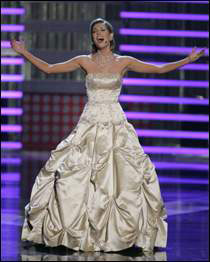
However, she failed to place, possibly because of her response during the question round. Asked what it says about American culture that people like Paris Hilton can be famous for not doing anything, she gave a rambling response about the importance of the Miss America pageant. She didn't fall over herself enough to make it on YouTube, but the response was the worst possible thing in a contest like this: forgettable.
The winner of the pageant distinguished herself in the talent competition with a sweeping, syrupy rendition of "Over the Rainbow," backed by a full orchestra. More so, though, she distinguished herself with her unforgettable dress, which made her look like an aqua peacock.
Truly, though, she won herself the pageant with her shrewd answer in the
question round. Asked if an HIV-positive or STD-positive person should
inform his or her fiancé of this condition, she answered that they
should, for health reasons. "It's a matter of respect," she
added, saying that respect is what keeps relationships and families strong.
As much fun as it might be to make fun or her sartorial choices, Haglund's platform issue is far from funny. As someone who formerly battled with anorexia, she hopes to draw attention to the issue of eating disorders. Perhaps this splash of new attention to the pageant will help her win attention for her cause.
A humble
suggestion: she could start by asking the pageant organizers to move the
talent and question rounds earlier in the competition, so that contestants
are judged on their smarts and their talent before they're judged on their
calves. Otherwise,
all the changes to Miss America are merely cosmetic.
Moral:
It takes more than a reality show to change lifelong habits.
Copyright
2008 by Alyce Wilson
What
do you think? Share your thoughts
at Alyce's message board (left button):
![]()
![]()
